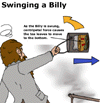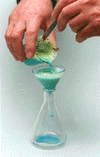Very large solid particles suspended in a liquid or gas will separate naturally from the liquid or gas under the natural force of gravity. Smaller solids suspended in a liquid or gas can be separated by filtration. This topic investigates some simple examples of separation by sedimentation and filtration.
Sedimentation
 Sedimentation occurs when the suspended particles are large enough to
settle to the bottom of a vessel under their own weight. Tea leaves falling
to the bottom in a tea cup, and mud settling to the bottom of a pond,
are examples of sedimentation in action. This process can be sped up by
spinning in a centrifuge, in the case of tea leaves, by swinging "the
billy" around in a circle a few times.
Sedimentation occurs when the suspended particles are large enough to
settle to the bottom of a vessel under their own weight. Tea leaves falling
to the bottom in a tea cup, and mud settling to the bottom of a pond,
are examples of sedimentation in action. This process can be sped up by
spinning in a centrifuge, in the case of tea leaves, by swinging "the
billy" around in a circle a few times.
A centrifuge can spin at great speed and creates a force many times that of gravity. Smaller particles that would not settle in a suspension will separate in a centrifuge. Blood cells can be separated from the plasma in blood by centrifuging.
Filtration
Solids, which do not normally settle out by sedimentation, can be separated
from their suspending liquid or gas by passing the mixture through filters.
Smoke filters on cigarettes, dust masks, coffee percolators, tea bags,
fish tank filters and the screens in sewerage treatment plants all use
filters to separate solids from a mixture.
Filtration works on the difference in particle sizes between the small liquid or gas molecules and larger solid particles. The smaller liquid and gas particles can get through the filter, while the larger solid particles are not allowed to pass.

|
A filter |
In the laboratory, chemists use filter paper to filter solids from liquid mixtures. Filter paper has tiny pores, which allow the small liquid molecules to pass easily, while not allowing the larger solid particles to pass through.
Separating chalk dust and water
This very simple experiment demonstrates separation by sedimentation
and filtration.
- Grind some chalk into a range of particles, from quite large chunks to fine dust.
- Shake the chalk dust with water, in a jar or beaker, and observe
for half an hour or so.
(The larger pieces will soon settle to the bottom of the container, followed by some of the finer dust particles.)
Some very fine chalk particles will stay suspended in the water for longer than half an hour. These can be separated from the water using filtration. - Make up a filter using filter paper, or some strong paper towel,
and pour the mixture through the paper.
(The chalk should remain in the paper and the water passes though slowly)
 An
interesting addition to this experiment is to show the difference in size
between particles in a suspension and particles in solution.
An
interesting addition to this experiment is to show the difference in size
between particles in a suspension and particles in solution.
- Finely grind up some yellow chalk.
- Add a small quantity of blue copper sulphate to some water and prepare
a solution.
- Add the yellow chalk to the blue solution. ( The mixture now turns
green!)
- Filter the chalk off from the solution. (The large chalk particles remain in the filter paper and the blue solution passes through.)
| Copyright owned by the State of Victoria (Department of Education and Early Childhood Development). Used with Permission. |
